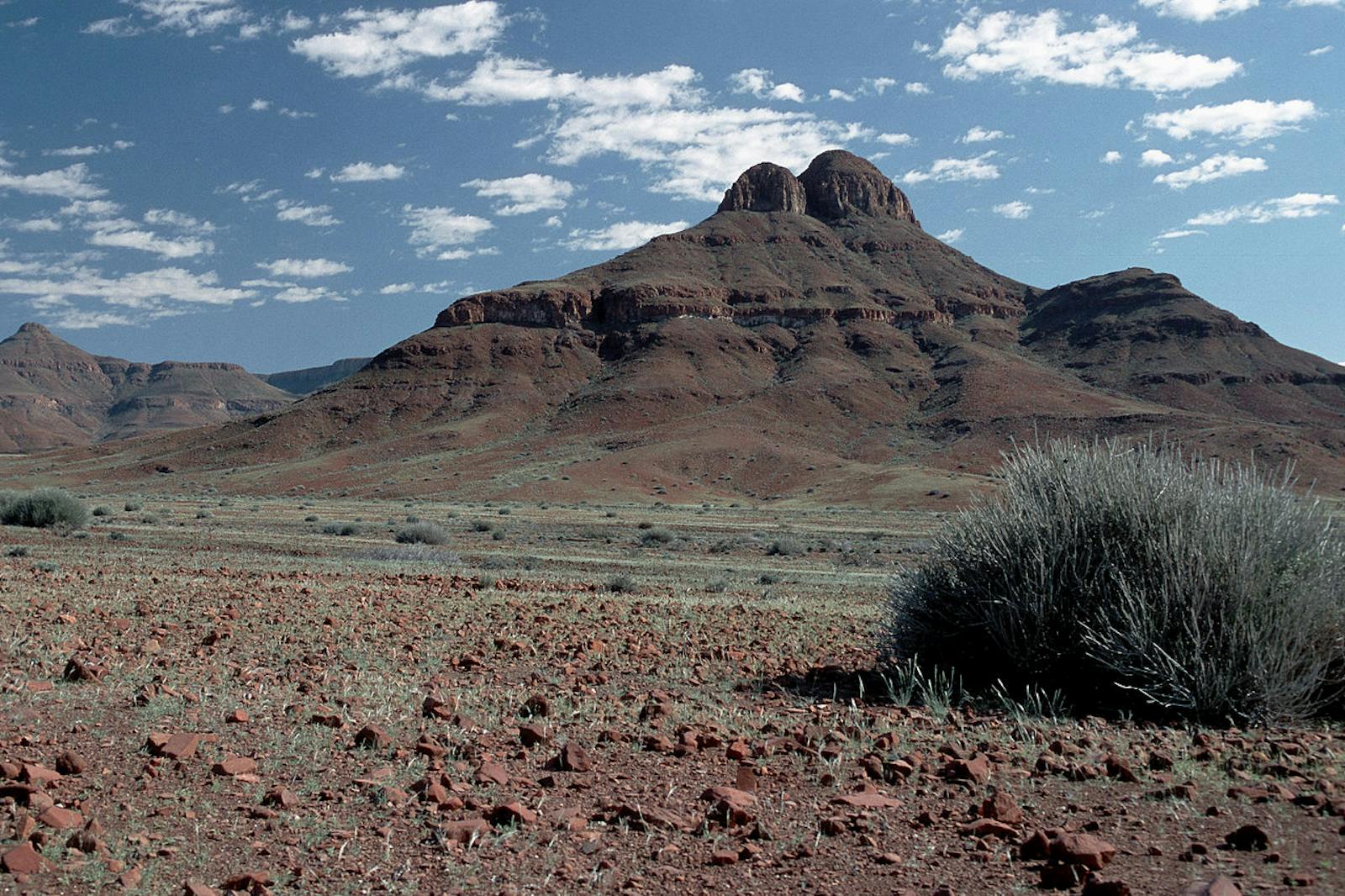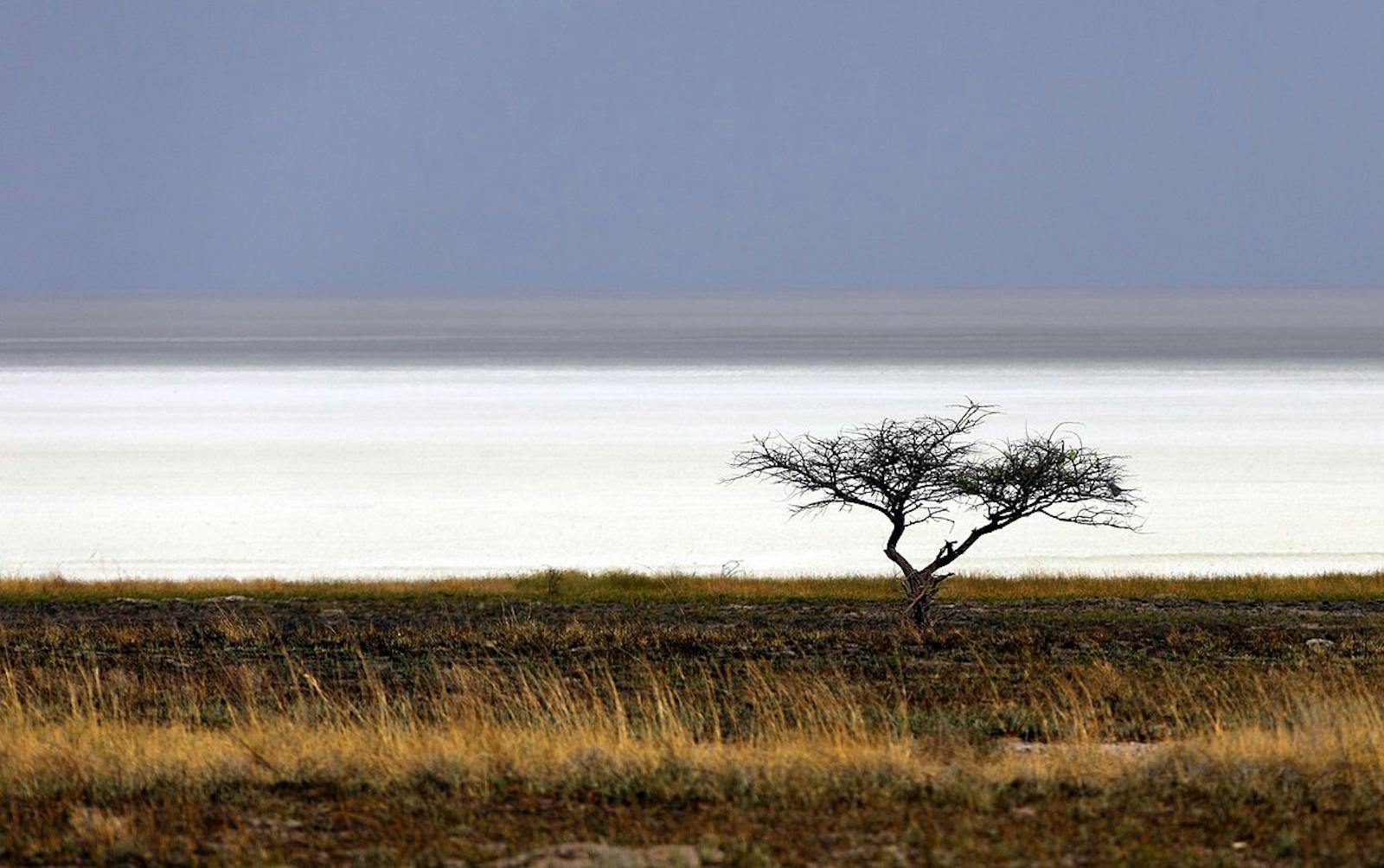Kaokoveld Desert
The ecoregion’s land area is provided in units of 1,000 hectares. The conservation target is the Global Safety Net (GSN1) area for the given ecoregion. The protection level indicates the percentage of the GSN goal that is currently protected on a scale of 0-10. N/A means data is not available at this time.
Bioregion: Southwest African Coastal Drylands (AT10)
Realm: Afrotropics
Ecoregion Size (1000 ha):
3,334
Ecoregion ID:
98
Conservation Target:
100%
Protection Level:
10
States: Angola, Namibia
The relict gymnosperm, Welwitschia mirabilis, consists of individual plants estimated at more than 2,500 years old. The plant is found scattered about the hyper-arid plains of the Kaokoveld Desert ecoregion and relies on regular fog formed when the cold Benguela Current meets the hot Namib Desert air. They provide vital refuge, shade, and water to many desert inhabitants. During times of drought, antelopes and rhinos chew the leaves to extract the moisture and then spit out the tough fibers.

The flagship species of the Kaokoveld Desert ecoregion is the Welwitschia mirabilis. Image Credit: Nano Sanchez, Wiki Creative Commons.
The ecoregion stretches along the west coast of southern Africa from the Uniab and Koigab Rivers in Namibia northwards into the Moçâmedes Desert of southern Angola. For most of its length, it is about 100 kilometers (62 mi) wide and extends from the Atlantic Coast to the foot of the Great Escarpment.
This ecoregion falls within the northern summer rainfall area of the greater Namib Desert, with most rain falling as sporadic thunderstorms between October and March. However, the most important climatic feature is the highly unpredictable rainfall of less than 100 millimeters (4 in) per year. Cool air moving inland off the Benguela current forms a stable layer of fog, which is blown inland as far as 50 kilometers (31 mi). The fog provides water to the desert plants and animals.
Air temperatures in the Kaokoveld Desert decrease towards the coast as a result of the cool air and frequent fogs, which keep daily and seasonal temperature changes to a minimum. Temperature extremes are even more pronounced inland, where they become highly variable, falling below 0° and rising above 50°C (32-122°F).
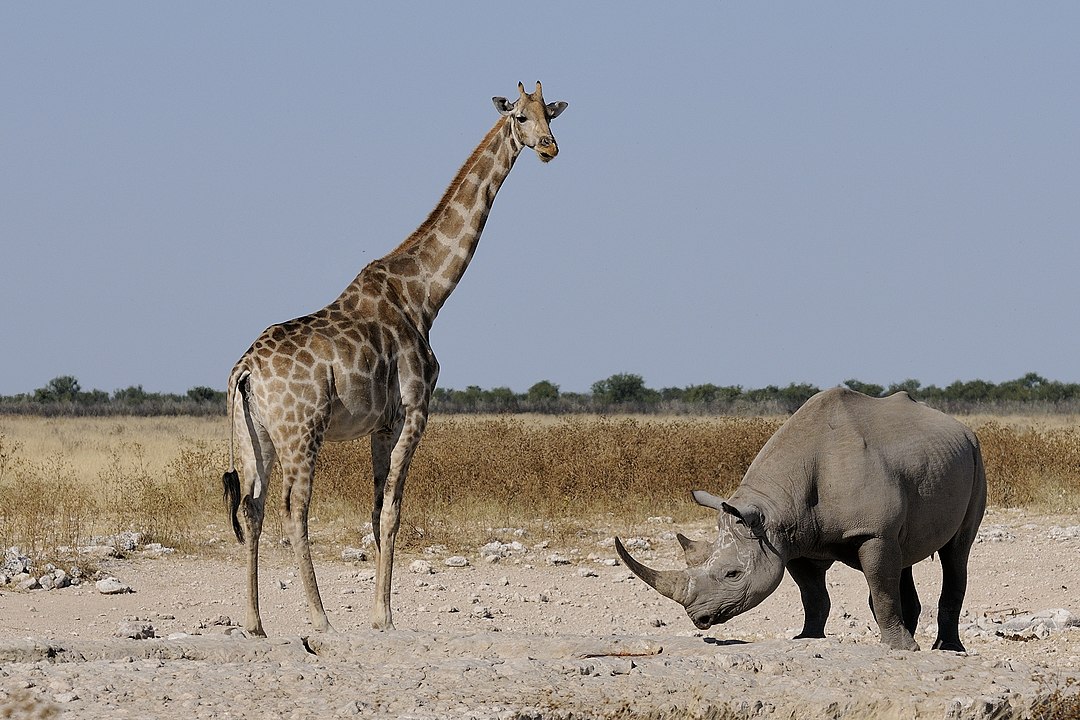
Meeting between black rhinoceros (Diceros bicornis) and giraffe (Giraffa camelopardalis). Image Credit: Hans Stieglitz, Wiki Creative Commons.
In some areas of the ecoregion, shifting sand dunes are completely devoid of vegetation, although elsewhere, Acanthosicyos horriduscolonizes the sand. Close to the coast, gravel deserts are devoid of vegetation except for colorful fields of foliose and crustose lichens. Further inland, the gravel deserts are less barren and support plants such as Zygophyllum simplex, Galenia Africana, Sesuvium portulacastrum, and Stipogrostis subacaulis.
Some areas of sparse grassland are found and support species such as Salsola nollothensis, Indigofero cunenensis, Stipagrostis ramulosa, and Eragrostis cyoeroides. Halophytic communities grow on saline beaches, characterized by Sesuvium spp., Suaeda fruitcosa, Scirpus littoralis, and Asthenatherum forsskalii.
The Kaokoveld Desert lies at the northern end of the Karoo-Namib regional center of endemism and represents a center of floral endemism. Families rich in endemic species include Acanthaceae, Asclepiadaceae, Burseraceae, Fabaceae, Poaceae, and Vitaceae. Ancient endemic species, such as Welwitscha mirabilis and Kaokochloa sp., indicate the ancient history of the area. Several plant species have disjunct distributions and may be relicts of a once continuous arid belt that stretched across Africa from Somalia to Botswana, Namibia, and South Africa.
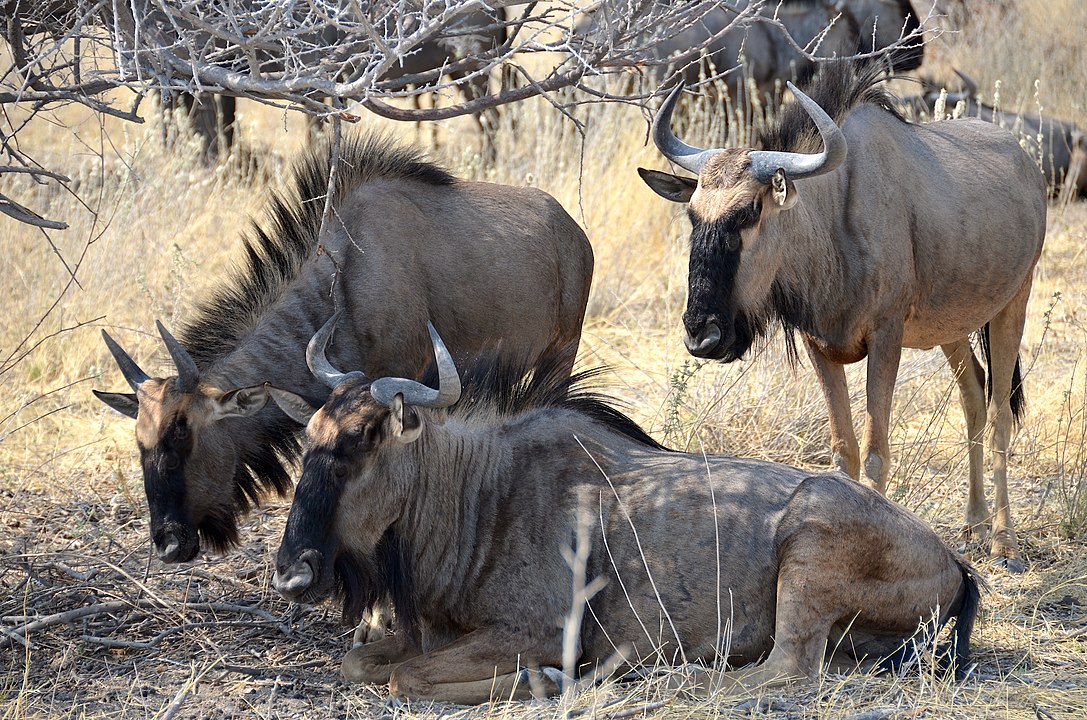
Blue wildebeest (Connochaetes taurinus). Image Credit: Olga Ernst, Wiki Creative Commons.
The Kaokoveld contains a number of invertebrate species, such as the endemic solifuge (sun spider) Ceroma inerme, which has adapted xerophilic behavior to accommodate a nearly marine existence, living just outside the high tidal zone and foraging in the intertidal area at low tide. The Kaokoveld Desert is home at times to ‘desert’ elephants, black rhinos, and giraffes, which are found in the riverbeds that fringe the desert. Other herbivorous mammals found within the ecoregion are springbok, gemsbok, Damara dik-dik, and black-faced impala.
Predators include lions, brown hyenas, and black-backed jackals. There are many species of birds in the ecoregion, with the highest diversity along riverbeds. For example, the endemic Cinderella waxbill is restricted to the Kunene riverbed. One of the few birds permanently residing within the sand dunes is the Gray’s lark.
A large percentage of this ecoregion falls under formal protection both in Namibia and Angola. The Skeleton Coast National Park stretches 500 kilometers (311 mi) along the northern coast of Namibia. The park contains the three main vegetation units found within the Kaokoveld Desert (gravel plains, sand dunes, and dry riverbeds). In Angola, the Namibe Partial Reserve stretches 4,450 square kilometers (1,718 sq mi), and the Iona National Park is 15,150 square kilometers (5,849 sq mi), covering most of the northern portion of the ecoregion.
The southeastern Kaokoveld was once under protection in “Game Reserve No. 2,” which originally covered 80,000 square kilometers (30,888 sq mi) and was the largest nature reserve in the world. Much of Game Reserve No. 2 was degazetted in 1963, but it is now regaining conservation status through a mosaic of informally protected conservancies that stretch from the Skeleton Coast Park and into the Kunene including Merienfluss and Orupembe communal conservancies.
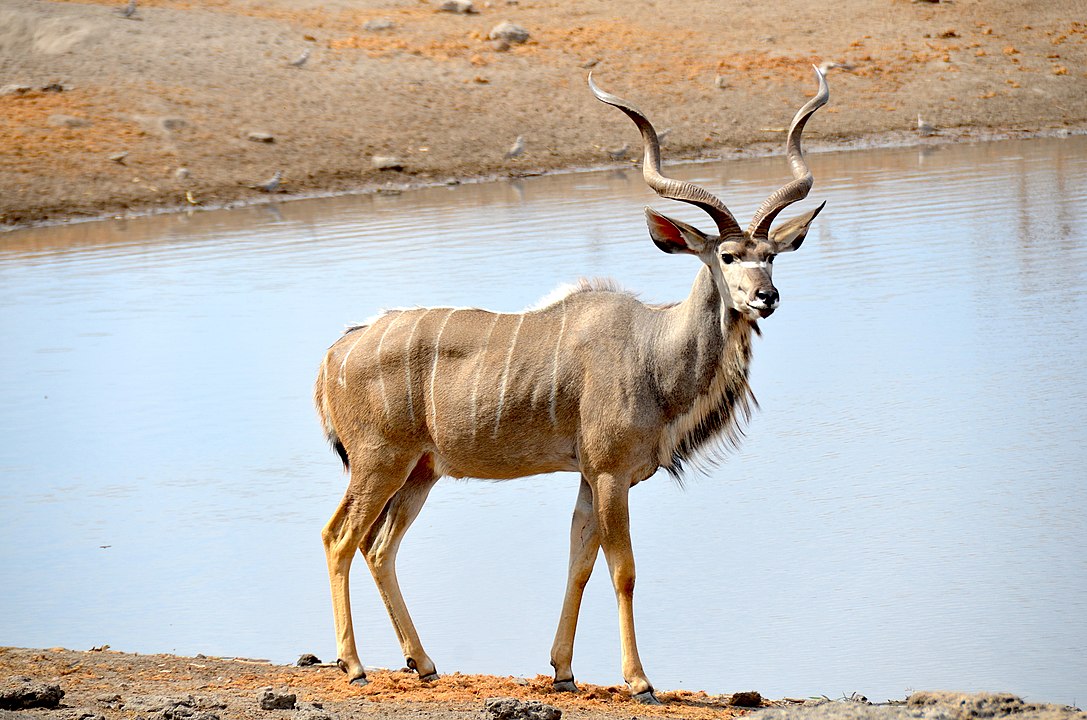
Greater kudu (Tragelaphus strepsiceros). Image Credit: Olga Ernst, Wiki Creative Commons.
The Namibian side of the Kaokoveld Desert has remained relatively intact because of its arid conditions and consequent low population density. To the east, the Ovahimba, who are nomadic pastoralists, primarily inhabit the ecoregion. Their impact on the habitats has been local, mainly through the collection of wood and medicinal, edible, and culturally important plants.
The biggest threat posed by the Ovahimba is through seasonal overgrazing by their cattle. The biggest threat to the Namibian side of the Kaokoveld Desert is from wildlife poaching. The 30-year civil war in Angola has left the Angolan side of the Kaokoveld Desert open to poachers, human settlement, and agriculture. There are several hundred Ovahimba pastoralists with more than 3,000 head of livestock within the Iona National Park.
The priority conservation actions for the next decade
1) It is crucial to strengthen wildlife laws and enhance enforcement capacity in order to effectively prevent poaching and the illegal trade in wildlife products.
2) Building the capacities of local communities to manage sustainable conservancies is essential, and it is important to encourage their active participation in these efforts.
3) Encouraging sustainable rangeland management practices, such as implementing grazing rotations, is vital for maintaining ecological balance and promoting biodiversity.
-
-
1. Burgess, N., Hales, J.A., Underwood, E., Dinerstein, E., Olson, D., Itoua, I., Schipper, J., Ricketts, T. and Newman, K. 2004. Terrestrial ecoregions of Africa and Madagascar: a conservation assessment. Island Press.
2. Valverde, A., De Maayer, P., Oberholster, T., Henschel, J., Louw, M.K. and Cowan, D. 2016. Specific microbial communities associate with the rhizosphere of Welwitschia mirabilis, a living fossil. PloS One. 11(4), p.e0153353.
3. Mufune, P. 2015. Community Based Natural Resource Management (CBNRM) and Sustainable Development in Namibia. Journal of Land and Rural Studies. 3(1), pp.121-138.
4. Government of the Republic of Namibia. 2014. Namibia’s Second National Biodiversity Strategy and Action Plan 2013 – 2022. Windhoek: Ministry of Environment and Tourism. -
Cite this page: Kaokoveld Desert. Ecoregion Snapshots: Descriptive Abstracts of the Terrestrial Ecoregions of the World, 2021. Developed by One Earth and RESOLVE. https://www.oneearth.org/ecoregions/kaokoveld-desert/
-
